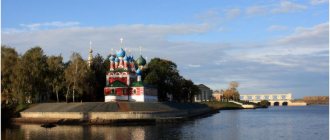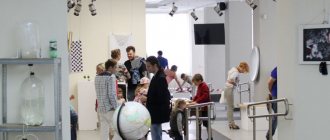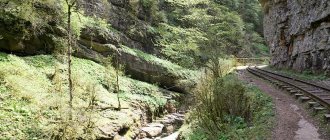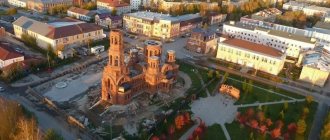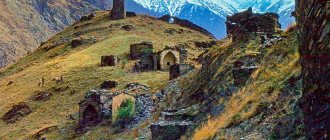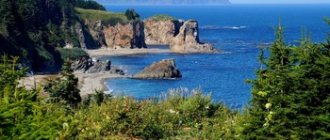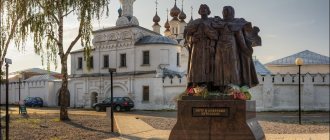The city of Gubakha is an ordinary industrial settlement on the map of the Northern Urals... only at first glance. Anyone who sees unique natural attractions with their own eyes is aware of the deceptiveness of this impression.
Museums and temples, mysterious ruins of “abandoned buildings” or become a guest of a landscape festival. It will take more than one eventful day to discover Gubakha. This is the real Ural.
Story
Gubakha is a city in the Perm region, the administrative center of the Gubakha urban district, located at a distance of 220 km from Perm, its index is 618250. The history of the development of the territory is associated with the mining of iron ore.
Its deposits were discovered here in 1755, and soon a settlement was founded at the place where the Gubashka River flows into the deeper Kosva, and the Gubakhinskaya pier appeared.
It was a transshipment point from which iron ore, delivered here from the Kizelovsky plant on horse-drawn carts, was floated on barges.
A new discovery that changed the life of the settlement was made at the beginning of the 19th century. It turned out that the region is also rich in coal.
There is a railway line here. At the beginning of the twentieth century, the Kizelovskaya State District Power Plant was built, and in 1939, the first coke production plant in the Urals began operating. Later, a hydroelectric power station was built in the village of Shirokovsky.
Until 1941, several workers’ settlements were located on this territory. Then they were united into the city of Gubakha with its center in Verkhnyaya Gubakha.
Museums and cultural life in Gubakha
Of course, a city like Gubakha cannot fail to show tourists the museums and theaters that city residents often visit to take a cultural break from the harsh workdays.
Metafrax Enterprise Museum
- Address: Zavodskaya st., 1, Ugleuralsky village.
has existed since 1955, now it is one of the largest enterprises in its industry. It operates a museum that is reputed to be innovative and high-tech.
Visitors are introduced to the features of chemical production through interesting, non-trivial exhibitions - LED models, holograms, and a virtual laboratory. The place and time of visiting the factory museum should be arranged in advance by telephone.
Museum of Military Glory of the Union of Veterans
- Address: st. Ordzhonikidze, 3.
The military museum operates under the city public organization Union of Veterans. The exhibition is structured by types of troops. Separate zones tell about sailors, border guards, landing forces and the National Guard.
Dominant Theater
- Address: st. Newspapers Pravda, 38.
The youth theater, opened in 2000 as a theater studio, is popular among townspeople and tourists. Today the troupe has a repertoire of more than 70 different productions, from classical to modern. In 2013, it was included in the list of leading cultural institutions.
Palace of Culture "Northern"
- Address: st. Mira, 28, Severny village.
The characteristic building with columns, a triangular portico and bas-relief makes it clear that this is a Soviet-era cultural center. The Severny Palace of Culture was opened in 1960. Today, it continues to be an important concert venue and center of cultural life, where clubs and sections for children and adults operate.
Ghost town "Old Gubakha"
The outskirts of Gubakha, looking at modern city blocks from the other bank of the Kosva, are occupied by unusual buildings. This is the so-called Old, or Upper Gubakha, ghost town.
How did a populated area that flourished during the Soviet years end up extinct? Its fate was once again determined by minerals.
Beginning in the 1960s, coal production in the Kizelovsky basin began to decline. And the factories located in the city, although they provided jobs to residents, poisoned the environment with harmful emissions.
The situation turned out to be so serious that the old city neighborhoods had to be abandoned. Abandoned adits and contaminated mine waters coming to the surface have a detrimental effect on the environment. Being a solution of sulfuric acid, they pose a threat not only to humans, but also to the animal and plant world.
The population of Upper Gubakha from the high right coast of Kosva was moved to another place, which was called Novaya Gubakha. All administrative, medical, educational institutions, and the passport office have also moved.
Life in the former historical center stood still, time stood still. But this also attracts tourists to the abandoned part of the city.
Where else can you stroll along streets paved with slag paving stones? And although only foundations remain of many residential and public buildings, there are interesting objects in Staraya Gubakha.
On a note! An informal symbol of the lost part of the city is the building of the Kalinin Mine Palace of Culture. Tourists love to take pictures at the ruins of the once beautiful grand staircase.
The building of the cultural center was built back in the 30s, during the heyday of the Stalinist Empire style. Old-timers remember that not only local artists performed on the stage of the Palace of Culture, but also artists who came on tour from the capital. There was also a cinema with 500 seats. Just half a century ago life was bustling here.
Nature: mountains and caves of Gubakha and its surroundings
In total, more than 70 caves have been discovered in the vicinity of the city, 40 of which are quite well known and studied. Below are the most popular caves among tourists, as well as some other interesting natural sites.
Rook Mountain
- Coordinates: 58.858124, 57.606628.
Along the left bank of the Kosva River, a geological section known as Lodeyny Log or Mount Ladeynaya stretches for 12 kilometers. This is a landscape natural monument where rare plants grow. The log is considered the longest in the region.
At the top of the mountain there is an observation deck that offers interesting views, a combination of natural and industrial landscapes.
Rook Mountain is famous for its caves and dumps, which are a legacy of the mining past. The Lodeynaya cave of the same name is small, the length of the passages is 162 meters, the height of the corridors varies from 2 to 6 m.
Palace Grotto
- Coordinates: 58.872495, 57.610002.
The remains of cave bears and mammoths were discovered in a small cave located in the territory of the “Old Gubakha” region, which has now become a ghost. The natural monument is known as the Palace Grotto. One of the exhibitions of the local history museum is dedicated to him.
Russian Cave
- Coordinates: 58.867500, 57.651393.
The 72-meter deep cave, about one and a half kilometers long, has become a “Mecca” for tourists and speleologists. One of its sections is quite simple to navigate, and a whole “underground city” opens before the visitor’s eyes.
There is an underground lake and several grottoes. The most famous are Lagerny and Gulliver. Both are favored by bats, which adds to the atmosphere of the place. An abundance of stalactites and stalagmites can be seen in the so-called “Wedding Gallery”.
Even children go down to the cave, but its simplicity is fraught with danger. The object became notorious throughout the country in 2009, when a tragedy occurred here: a collapse covered a group of six people.
Karst failure named after Smirnov
- Coordinates: 58.821164, 57.611989.
A funnel with a diameter of 90 and a depth of 40 meters with a moss-covered bottom is the most famous karst hole in Ladeyny Log. Sometimes, after the name of the mountain, it is called “Rook Failure”. The object was named after the geologist, Hero of Socialist Labor, academician Vladimir Smirnov.
Obvalnaya Cave
- Coordinates: 58.834825, 57.611465.
One of the most famous caves on Ladeynaya Mountain. It is a complex of galleries and grottoes. It consists of two levels or floors, which are separated by a 12-meter well. In 1974 it received the name of the famous researcher Maksimovich.
Belaya Gora section
- Coordinates: 58.884392, 57.616332.
Within the city there is a rock massif - the Belaya Gora geological section. Recognized as a unique geological object. Connoisseurs of nature are also interested in White Mountain as a place of growth of a plant listed in the Red Book – Shiverekia Podolskaya.
Mariinskaya Cave
- Coordinates: 58.867499, 57.651388.
On White Mountain there is an entrance to a four-tier karst cave 50 meters deep. It's called Mariinskaya. Inside the cave you can see many wells and centuries-old accumulations of ice with a length of 62 meters. Also noteworthy is the “Mushroom Grotto”, where a unique cave mushroom of an unknown biological species is found.
Cave "Right Boot"
- Coordinates: 58.867173, 57.650935.
“The Right Boot” is a small cave twenty meters deep, located in an easily accessible place for tourists, on Kholodny Log. Its second name is Cold. At the bottom of the cave there is a grotto and an underground lake with an area of 15 meters and a depth of about half a meter. It is recommended to go down to the bottom only with special equipment and certain skills. Arriving at the cave in spring, you can see a beautiful waterfall.
origin of name
The official version explaining the origin of such an unusual name for the city says: the word “Gubakha” was formed from an anthroponym. It means “man with thick lips.”
Interesting fact! There are also alternative versions of the words that gave the name to the settlement, from an edible mushroom and a twisted tree to a wooden platform for building barges and a piece of land protruding into a body of water.
In total, Ural local historians counted twelve possible options for the origin of the name. Which one is closest to the truth is unknown.
KUB Museum
⠀ KUB Museum - Museum of the Kizelovsky Coal Basin. Gubakha is considered a mining town and the museum talks about coal, its properties, history and production. Even the decoration of the museum - the wall paintings - are made with charcoal. Did you know that the oldest coal is 300-400 million years old? The museum is interactive, modern information technologies are actively used.
On the street next to the museum you can see examples of mining equipment: trolleys, electric locomotives: Museum of the Kizelovsky Coal Basin in Gubakha. How to get there, what to see, photos.
Address: 618250, Russia, Perm region, Gubakha, Lenin Ave., 38 Director: Khoromanskaya Natalya Yuryevna Opening hours: from Mon to Thu - from 10.00 to 19.00; Fri - from 10.00 to 20.00; Sat - from 10.00 to 18.00; Sunday is a day off. Email page on social networks: https://ok.ru/profile/567550083996; https://vk.com/muzeiuglia
Attractions
Little Gubakha attracts tourists primarily with the opportunity to ski. Here is one of the best ski resorts in the entire Urals with 18 slopes, a snow park, and freeride areas.
But the town itself has prepared many pleasant surprises for tourists in the form of interesting sights. A special flavor here is created thanks to traces of historical events and numerous art objects.
Tourists love to take photos against the backdrop of the inscription “Happiness in the Mountains.” She can be seen on social networks and blogs. The Perm region city of Gubakha offers other attractions.
Gubakhinsky Museum of History and Local Lore
Address: Lenin Ave., 38.
The almost 300-year history of the settlement is associated with coal mining. Most city residents have at least one miner in their family. Visitors to the Gubakha Coal Museum, or the KUB Museum, are told about these and many other interesting facts.
It opened in 2014 as a tribute to the area's mining past. The starting point of the exhibition of the unusual museum is graffiti, which reflects the phenomenon, history and future of the unique combustible stone.
Museum of Military Glory of the Union of Combat Veterans
Address: st. Ordzhonikidze, 3.
The museum was created under the Union of Combat Veterans. It is popular among young people: schoolchildren and students.
The exhibition is dedicated to sailors, paratroopers, border guards and representatives of other branches of the military, their difficult service, heroic pages of history, and biographies of famous people.
Excursions in the museum are interesting because you can learn about military operations from direct participants who act as guides.
Temple in honor of the icon of the Mother of God of All Who Sorrow Joy
Address: Lenin Ave., 50.
The majestic red brick temple, built in 2007 with donations from parishioners, has become one of the architectural dominants of Gubakha. Its construction was a significant event for believers, because previously services were held in an empty sports school.
Now in the temple you can see several shrines: icons with particles of the relics of the Great Martyr Panteleimon, St. Seraphim of Sarov and the Holy Blessed Matrona of Moscow.
Church of the Vladimir Icon of the Mother of God
Address: st. Nikonova, 41.
The church is located in a building built back in 1956 for a kindergarten. In the 90s it was transferred to the Russian Orthodox Church.
New Life Church
Address: st. Newspapers Pravda, 8A.
In Gubakha there is also a church for Presbyterian Christians of the evangelical faith. It opens for worship once a week, on Sundays, at 12 o'clock.
Monument to the Permian period
Address: intersection of Lenin Ave. and Oktyabrsky Ave.
Gubakha can be called a city of art objects. With the help of installations, residents celebrate significant events in the history of the region.
One of them is a monument to the Permian period, which popularly received the humorous name “Turbocharger”. It is a huge mollusk shell. In ancient times, similar ammonites inhabited the Ural Sea that existed in this area.
On a note! Ammonites are still found in rock formations near the city. You can try your luck and take away an unusual souvenir from the Ural Mountains.
Square "Ural Ocean"
Address: Lenin Ave., 38.
Another landmark of the city of Gubakha, a public garden with the unusual name “Ural Ocean”, addresses the theme of the distant past. It is adjacent to the building of the local history museum.
It is decorated with six art objects beloved by local residents in the form of ocean inhabitants who lived during the Permian period. The monuments are connected by a symbolic river made of small stone and jasper.
Square "QR code"
Address: st. Newspapers Pravda, 38.
If it may seem to someone that there is nothing interesting in the city other than references to distant historical events, then this impression will be erroneous.
The modern era and new information technologies have not spared Gubakha. A clear example of this is the square in the form of a giant QR code. You can come here to connect to free internet.
Suspension bridge
Coordinates: 58.863293, 57.611389.
This bridge is notable for being the longest in the Perm region. It connects the banks of Kosva. Previously it was part of the road between the villages of Kirovsky and Zagubashka.
Now it is dangerous to use the old suspension bridge, built from ropes and cords. But this doesn’t stop thrill-seekers, especially since you can take a spectacular photo on the bridge.
Scenery of the film “The Heart of Parma”
Coordinates: 58.581899, 57.771761.
After a film crew filmed the film “The Heart of Parma” in the city’s surroundings, a new attraction appeared here.
As a set, the filmmakers built a wooden fortress, a chapel, a stable and a barn, stylized as buildings from the 15th century. Now they have become a full-fledged tourist attraction. You can see the scenery in the countryside, near the village of Zagubashka on the banks of the Kosva.
What to see for a tourist in Gubakha in 1 day
Now Gubakha is a city of regional significance, an agglomeration that includes an urban settlement and several surrounding villages. Historically, many sites of note for tourism are not located in the city center, but on the outskirts or in the surrounding area. At the beginning, there are sights that you should definitely pay attention to when arriving in Gubakha.
Mount Krestovaya
- Coordinates on the map: 58.853370, 57.581842.
The northern peak of the Ural ridge Rudyansky mountain is Mount Krestovaya. This is not only a remarkable natural site, but also an important place from a historical point of view. This mountain is the ancestor of the city of Gubakha.
It was here that an iron ore deposit was discovered back in the 18th century. In 1755, a metallurgical plant was founded, and at the foot, along the banks of the Kosva River, the village of Gubakha arose. In the 19th century, coal was also discovered on the mountain, which determined the specifics of the settlement.
From the first cast iron smelted at a local plant, a cross was made that was installed on the mountain, which is why it became known as Krestovaya. The length of the mountain range is 4 kilometers, and the maximum height of the mountain is just over 450 meters. As a geological and paleontological monument, the mountain is interesting for its unique flora and evidence of antiquity.
Every year, the landscape and theater festival “Secrets of Mount Krestovaya” is held here; on the stage, which is installed right on the mountain, legendary productions have been presented over the years, including “Romeo and Juliet”, “Juno and Avos”.
The holding of such events determines the city’s potential as a place for the development of event tourism. Many people come to Gubakha during the festival.
Ski
- Address: Krasnooktyabrskaya st., 28.
One of the first associations that tourists have when hearing the word “Gubakha” is alpine skiing. The ski center of the same name in the village is located directly on the slope of Mount Krestovaya. A noticeable art object in the form of the inscription “Happiness in the Mountains” is located here. It greets all guests of the center and is clearly visible from afar.
The ski center offers 18 trails of varying lengths and degrees of difficulty for active recreation enthusiasts. Visitors will be pleased with the developed infrastructure.
On the territory there is a small zoo, a sauna, and several food outlets, including a popular alpine-style cafe. You can spend several days in the complex, staying overnight in a hostel or hotel. Excursions are organized for tourists at the ski center.
Dark Cave
- GPS coordinates: 58.945066, 57.651643.
Gubakhinsky caves are another symbol of the area and a tourist brand. One of the many caves here is considered the largest and deepest in the Perm region.
The Temnaya cave is recognized as a geological monument, located between the city of Gubakha and the village of Ugleuralsky. It was discovered by geology students in the 1950s. It was first mentioned in the scientific works of Georgy Maksimovich and Klara Gorbunova, dated 1958.
The cave goes 132 meters deep, and its length, according to various sources, reaches from 1.5 to 4 km. Underground lakes spill inside. It is no coincidence that the cave has a gloomy name: it is a mysterious place around which there are many mystical legends.
In reality, the cave is fraught with danger, it is one of the most difficult, its passage is accessible only to experienced speleologists. The object is also interesting from an archaeological point of view; sites of ancient people were discovered here.
Museum of History and Local Lore and the KUB Museum
- Address: ave. Lenina, 38.
The history of Gubakha and the surrounding area is inextricably linked with coal mining; it is the coal theme that is central to the main city museum of local history. The Kiesel Coal Basin Museum is part of it and is located at the same address. The exhibition tells about the stages of development of coal deposits, the features of its extraction and properties.
In the halls of the local history museum, permanent and temporary exhibitions, topics related to the history of the city’s formation are also revealed, local caves and paleontological finds, and the peculiarities of the local nature are revealed.
The Gubakhinsky Museum of Local Lore arose thanks to the people's initiative. The starting point of its history is considered to be 1966, when a note appeared in the local newspaper calling on citizens to participate in the formation of funds, and the following year the museum opened its doors. The first director was a veteran of the Great Patriotic War, Pavel Zhdanov. For decades the museum remained a public museum, and in the 1990s it became a municipal one.
In 2014, the cultural institution moved to a new building, and at the same time the exhibition “CUBE Museum” began to take shape on its basis.
Kosva River
- Coordinates: 58.862955, 57.558516.
Gubakha stands on both banks of the Kama tributary - the Kosva River. The total length of the water artery is 870 km; it flows through the territory of the Perm Territory and the Sverdlovsk Region. The hydronym is of Komi-Permyak origin. Kosva is translated as “rapid water.”
This is a mountain river, it traditionally attracts lovers of extreme recreation and rafting. Historically, the river also had transport significance; coal and cast iron were transported along it.
The river banks in the Gubakha area are rocky and very beautiful. The city and its surroundings are a great place to admire the scenery of a mountain river and get up close and personal with a body of water, which in many other places remains difficult to access. The river is held in high regard by fishermen. The catches here are rich.
How to get there
You can get to Gubakha in the Perm Territory by various types of public transport:
- By plane. From Moscow or other cities you can fly to Perm Bolshoye Savino Airport. Next, you need to transfer to a train, bus, or car.
- By train. You can get to Gubakha Passazhirskaya station:
- from Moscow with one transfer to a commuter train at Chusovskaya station;
- from Perm - first by bus from the bus station to Usva station, then by commuter train to Gubakha Passazhirskaya;
- from Perm by commuter trains with a transfer at Chusovskaya station;
- from Perm by commuter train to Kizel, then by train 604 E “Solikamsk - Ekaterinburg”.
- By bus. From Perm from the bus station along the route "Perm - Kizel", from Yekaterinburg - in the direction to Solikamsk, the bus goes through Gubakha.
Composition of the urban district
| № | Locality | Type of settlement | Population |
| 1 | 10 km | village | 1114[8] |
| 2 | 20 km | village | 231[8] |
| 3 | Gubakha | city, administrative center | ↘20 645[1] |
| 4 | Keys | village | 13[8] |
| 5 | Nagornsky | village | ↘477[8] |
| 6 | Parma | railroad station | 310[8] |
| 7 | Ugleuralsky | town | ↘9250[1] |
| 8 | Shestaki | railroad station | 66[8] |
| 9 | Shirokovsky | town | ↘3236[1] |
Useful tips for tourists
The city welcomes guests in both warm and cold seasons. Here you can always find activities to your liking. But it makes sense to come here only for active recreation: alpine skiing, mountain walks, descents into caves.
The main tourist destination in this area is the ski resort. There are trails for independent skiing here. But you can also enroll in a ski school. We accept both children and adults for group and individual lessons.
The weather in the Perm region is replete with precipitation. Therefore, in spring or autumn you cannot do without a raincoat and waterproof shoes. To explore the surroundings of Gubakha, it is worth taking with you comfortable shoes with non-slip soles.
In mountainous areas, the wind is felt sharply, clothing should protect against its gusts. In winter, there are no snowdrifts on the main tourist routes; the paths are well-trodden.
You can stay in Gubakha in one of several guest houses. Not far from the city, in the village of Ugleuralsky, there is the Metafrax sanatorium, which offers many health treatments. The dispensary is equipped with water and mud baths.
Gubakha: beautiful monuments and sculptures
One of the “tricks” of Gubakha is the abundance of original, unusual monuments and art objects. There are also standard typical monuments in the city.
Shell Ammonite, or Monument to the Permian period
- Address: Lenin Avenue.
A dedication to the Ural Ocean and the entire Permian period was the sculpture of the ammonite cephalopod, an ancient inhabitant of the seas. The object is popularly called a shell. The monument project was developed by employees of the Northern Crown agency, and was built with the financial participation of the Metafrax enterprise.
Sculpture "Rainbow Bird-Lizard"
- Address: Gazety Pravda street.
A colorful wooden sculpture is a modern embodiment of the image of an ancient inhabitant of the earth from the Permian period. This is how the author from Pskov, Daria Lisitsyna, a participant in the art residency held in Gubakha in 2014, sees it.
The original author's name of the object was “Rainbow Bird-Lizard”. Residents of the city gave the creature a human name - Igor, and politely call him “Igor Gorynych”, “Ptitsezarv Igor” or simply “Igorek”. Another simple folk name is Dinosaur.
Time capsule
- Address: st. Degtyareva, 9.
A symbolic art object near the city library is the creation of a foreigner from sunny Mexico. His name is Luis Valverde. The Latin American was inspired to create the “Time Capsule” by visiting Verkhnyaya Gubakha, a once developed industrial city that became a “ghost”. With his sculpture, the foreign master symbolizes the transience of time and appeals to the memory of bygone eras.
Monument to Yu.A. Gagarin
- Address: Lenin Avenue.
Long before the appearance of the object of the same name in Gubakha, the local monument to Yu.A. was associated with the “Time Capsule”. Gagarin. This was walled up here in 1975, when the monument was opened.
The Gubakhinsky embodiment of the space pioneer is recognized as one of the most unusual and unique monuments to a historical figure.
The bust of an astronaut in a spacesuit is mounted on a metal inclined stele-pedestal. According to many, the monument, symbolizing the desire for the stars, reflects the character and tragic fate of the hero.
Sculpture “Bird of Happiness”
- Address: Lenin Avenue.
In 2012, as part of the project “Perm Region – Territory of Culture”, the art object “Bird of Happiness”, the creation of a group of St. Petersburg artists, was installed in Gubakha. People call the colorful statue various things – “Peacock”, “Rooster”, and “Firebird”. The object is equipped with a backlight that turns on in the evening.
Methanol Formula
- Address: Zavodskaya st., 1, Ugleuralsky village.
The Metafrax enterprise is a city-forming enterprise. The company specializes in methanol production. It is logical that the city's latest art installation, installed in 2022, is dedicated to this substance.
Monument to the Gubakha wars, defenders of the Motherland
- Address: Victory Park.
The square, laid out in the 60s, became a place of memory of the Great Patriotic War. On May 9, 1975, a statue of a soldier was installed here - the central object of the city war memorial.
The design of the monument was created by V. Ushakov and V. Kotlas, and the sculpture was made in Nizhny Tagil. In 1985, the Eternal Flame was lit next to the monument. In subsequent years, the complex was supplemented with memorial plaques.
Reviews
Irina Smelkovskaya, 29 years old, Tchaikovsky
“We first came to Gubakha at the invitation of friends living in the nearby village of Shirokovskoye. But I would like to talk separately about the natural monument Stone Town. You can get to it from Gubakha in literally 15–20 minutes. This is a system of crevices in the rock mass, which somehow reminded me of city avenues and streets. I came here in the fall, so there was mud crunching under my feet, there was light rain, from which there was nowhere to hide, but the views were simply fabulous. I especially remember the stones with the names Big and Small Turtle.”
Museum of the city-forming enterprise "Metafrax"
They say you should definitely visit the Museum of the city-forming enterprise Metafrax. They talk about it, but there is no photo anywhere. According to information from the Internet, this is an innovative museum where you can see a light-dynamic model of the enterprise and a holographic screen that allows you to see the work of a virtual “chemical laboratory” in space. But it’s not clear how to get to the museum. But you can try calling in advance as there is no such address: Gubakha, 618250, . Phone: (34248) 4-08-98.

